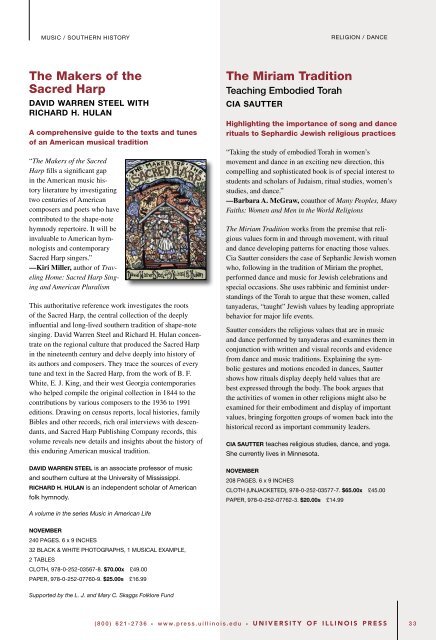Fall 2010 - University of Illinois Press
Fall 2010 - University of Illinois Press
Fall 2010 - University of Illinois Press
You also want an ePaper? Increase the reach of your titles
YUMPU automatically turns print PDFs into web optimized ePapers that Google loves.
Music / Southern History<br />
Religion / Dance<br />
The Makers <strong>of</strong> the<br />
Sacred Harp<br />
David Warren Steel with<br />
Richard H. Hulan<br />
A comprehensive guide to the texts and tunes<br />
<strong>of</strong> an American musical tradition<br />
“The Makers <strong>of</strong> the Sacred<br />
Harp fills a significant gap<br />
in the American music history<br />
literature by investigating<br />
two centuries <strong>of</strong> American<br />
composers and poets who have<br />
contributed to the shape-note<br />
hymnody repertoire. It will be<br />
invaluable to American hymnologists<br />
and contemporary<br />
Sacred Harp singers.”<br />
—Kiri Miller, author <strong>of</strong> Traveling<br />
Home: Sacred Harp Singing<br />
and American Pluralism<br />
This authoritative reference work investigates the roots<br />
<strong>of</strong> the Sacred Harp, the central collection <strong>of</strong> the deeply<br />
influential and long-lived southern tradition <strong>of</strong> shape-note<br />
singing. David Warren Steel and Richard H. Hulan concentrate<br />
on the regional culture that produced the Sacred Harp<br />
in the nineteenth century and delve deeply into history <strong>of</strong><br />
its authors and composers. They trace the sources <strong>of</strong> every<br />
tune and text in the Sacred Harp, from the work <strong>of</strong> B. F.<br />
White, E. J. King, and their west Georgia contemporaries<br />
who helped compile the original collection in 1844 to the<br />
contributions by various composers to the 1936 to 1991<br />
editions. Drawing on census reports, local histories, family<br />
Bibles and other records, rich oral interviews with descendants,<br />
and Sacred Harp Publishing Company records, this<br />
volume reveals new details and insights about the history <strong>of</strong><br />
this enduring American musical tradition.<br />
David Warren Steel is an associate pr<strong>of</strong>essor <strong>of</strong> music<br />
and southern culture at the <strong>University</strong> <strong>of</strong> Mississippi.<br />
Richard H. Hulan is an independent scholar <strong>of</strong> American<br />
folk hymnody.<br />
The Miriam Tradition<br />
Teaching Embodied Torah<br />
Cia Sautter<br />
Highlighting the importance <strong>of</strong> song and dance<br />
rituals to Sephardic Jewish religious practices<br />
“Taking the study <strong>of</strong> embodied Torah in women’s<br />
movement and dance in an exciting new direction, this<br />
compelling and sophisticated book is <strong>of</strong> special interest to<br />
students and scholars <strong>of</strong> Judaism, ritual studies, women’s<br />
studies, and dance.”<br />
—Barbara A. McGraw, coauthor <strong>of</strong> Many Peoples, Many<br />
Faiths: Women and Men in the World Religions<br />
The Miriam Tradition works from the premise that religious<br />
values form in and through movement, with ritual<br />
and dance developing patterns for enacting those values.<br />
Cia Sautter considers the case <strong>of</strong> Sephardic Jewish women<br />
who, following in the tradition <strong>of</strong> Miriam the prophet,<br />
performed dance and music for Jewish celebrations and<br />
special occasions. She uses rabbinic and feminist understandings<br />
<strong>of</strong> the Torah to argue that these women, called<br />
tanyaderas, “taught” Jewish values by leading appropriate<br />
behavior for major life events.<br />
Sautter considers the religious values that are in music<br />
and dance performed by tanyaderas and examines them in<br />
conjunction with written and visual records and evidence<br />
from dance and music traditions. Explaining the symbolic<br />
gestures and motions encoded in dances, Sautter<br />
shows how rituals display deeply held values that are<br />
best expressed through the body. The book argues that<br />
the activities <strong>of</strong> women in other religions might also be<br />
examined for their embodiment and display <strong>of</strong> important<br />
values, bringing forgotten groups <strong>of</strong> women back into the<br />
historical record as important community leaders.<br />
Cia Sautter teaches religious studies, dance, and yoga.<br />
She currently lives in Minnesota.<br />
NOVEMBER<br />
208 PAGES. 6 x 9 INCHES<br />
CLOTH (UNJACKETED), 978-0-252-03577-7. $65.00x £45.00<br />
PAPER, 978-0-252-07762-3. $20.00s £14.99<br />
A volume in the series Music in American Life<br />
NOVEMBER<br />
240 PAGES. 6 x 9 INCHES<br />
32 BLACK & WHITE PHOTOGRAPHS, 1 MUSICAL EXAMPLE,<br />
2 TABLES<br />
CLOTH, 978-0-252-03567-8. $70.00x £49.00<br />
PAPER, 978-0-252-07760-9. $25.00s £16.99<br />
Supported by the L. J. and Mary C. Skaggs Folklore Fund<br />
(800) 621-2736 • www.press.uillinois.edu • <strong>University</strong> <strong>of</strong> <strong>Illinois</strong> <strong>Press</strong> 33



